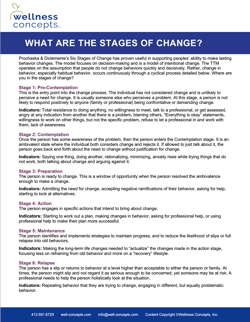When we're on a road trip, we often use GPS. Even if we have an idea of where we're going, it's helpful to track how far we've come, know how long it will take to get there, or to see if there is traffic ahead. When we are trying to make a change, it's also helpful to see where we are in our journey. Check out the Stages of Change handout below adapted from our 30 Days to Becoming Nicotine-free Challenge to help you see where you are on your path to change. Download for a printable version of the worksheet.
Prochaska & Diclemente’s Six Stages of Change has proven useful in supporting peoples’ ability to make lasting behavior changes. The model focuses on decision-making and is a model of intentional change. The TTM operates on the assumption that people do not change behaviors quickly and decisively. Rather, change in behavior, especially habitual behavior, occurs continuously through a cyclical process detailed below. Where are you in the stages of change?
Stage 1: Pre-Contemplation
This is the entry point into the change process. The individual has not considered change and is unlikely to perceive a need for change. It is usually someone else who perceives a problem. At this stage, a person is not likely to respond positively to anyone (family or professional) being confrontative or demanding change.
Indicators: Total resistance to doing anything, no willingness to meet, talk to a professional, or get assessed, angry at any indication from another that there is a problem, blaming others, “Everything is okay” statements, willingness to work on other things, but not the specific problem, refuse to let a professional in and work with them, lack of awareness.
Stage 2: Contemplation
Once the person has some awareness of the problem, then the person enters the Contemplation stage. It is an ambivalent state where the individual both considers change and rejects it. If allowed to just talk about it, the person goes back and forth about the need to change without justification for change.
Indicators: Saying one thing, doing another, rationalizing, minimizing, anxiety rises while trying things that do not work, both talking about change and arguing against it.
Stage 3: Preparation
The person is ready to change. This is a window of opportunity when the person resolved the ambivalence enough to make a change.
Indicators: Admitting the need for change, accepting negative ramifications of their behavior, asking for help, starting to look at alternatives.
Stage 4: Action
The person engages in specific actions that intend to bring about change.
Indicators: Starting to work out a plan, making changes in behavior, asking for professional help, or using professional help to make their plan more successful.
Stage 5: Maintenance
The person identifies and implements strategies to maintain progress, and to reduce the likelihood of slips or full relapse into old behaviors.
Indicators: Making the long-term life changes needed to “actualize” the changes made in the action stage, focusing less on refraining from old behavior and more on a “recovery” lifestyle.
Stage 6: Relapse
The person has a slip or returns to behavior at a level higher than acceptable to either the person or family. At times, the person might slip and not regard it as serious enough to be concerned, yet someone may be at risk. A professional needs to help the person holistically look at the situation.
Indicators: Repeating behavior that they are trying to change, engaging in different, but equally problematic behavior.


